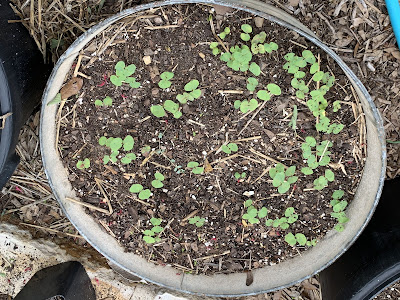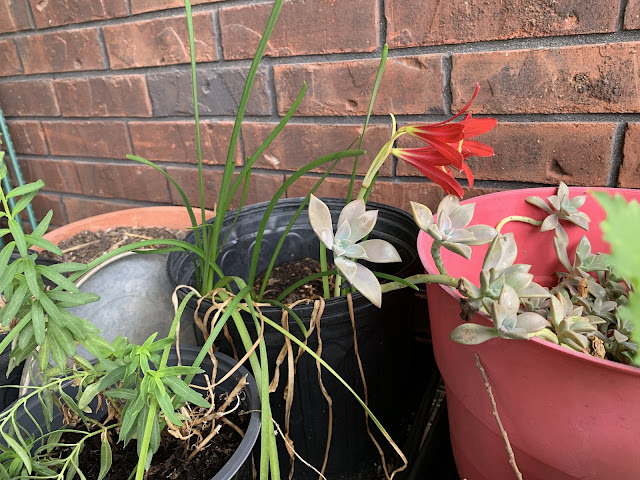The Kidneywood on the left is the star of the garden this year. It's beautiful and allegedly a favorite of butterflies and bees. It's hard to tell - there's much competition.
I keep trying to develop a way of keeping track of the gardens - wild and vegetable. Avoiding replanting of those things that have refused residence would be nice. A list of overly aggressive plants would also help. But what I have learned is that plants behave differently in this garden. Things that grow for my brother and sister laugh at me. Plants that don't thrive in their gardens consume any spare space for me. And growth, even in a time of drought has been surprising.*
What's new?
This year I located plants I wanted - Mexican Buckeye and Texas Redbud for two. Having seen a Kidneywood in a friend's bird photos, I sought one out. It is definitely a standout in the garden. I'm going to need to see about how to train it as it more than filled its allotted area.
And I've gathered a few chose and volunteer spot fillers. Both basils (Italian and common) have self-seeded throughout the garden. The pollinators love them, so who am I to pull up these lovely and useful plants. My Tropical sage took over the left side of the wild garden. Other plants (and St. Frank) have been swallowed up by the lipstick red sage. Only now have I pulled a few plants that had spread into the walkway of the raised garden area (there are two basil and one milkweed there as well, but I let them stay).
Oh, almost forgot the sunflowers. I had sunflowers I planted, birds planted (from sunflower mixes) and that are the common type from the area. I left a number of plants up to feed the birds and the birds have LOVED them. I've seen all kinds of sparrows, Lesser Goldfinches, House Finches, at least one Red-winged Blackbird and a few doves (mostly white-winged) on the plants. The hummingbirds hang out there as well, apparently after garden spiders.
I've some bulbs coming up. They aren't natives, but I couldn't help myself. I suppose I am feeling confident enough to expand the plantings in the wild. It's never been a "native" garden although there are many natives planted there. So, what the heck....
What has struggled?
The Elderberry fell and have looked less than their lovely selves. The Copper Canyon Daisy is all but gone after splitting last year. Schoolhouse (oxblood) lilies are missing (swallowed by sages). I don't know if they are under the growth or not. Cut-leaf Daisies grew tall and fell over in the wind. They will be propped in the future. Many plants have struggled from an infestation of aphids. They have gone after Altheas, milkweed, and other plants I probably haven't remembered. Why? NO Ladybugs! Where are the ladybugs? I can only think the drought got to them or else some predator was at work in the garden. I'll order some next year.
Insects?
All in all the insect population was down. I still had a few wasps, but no stings so far. The fire ants moved around as I sprinkled diatomaceous earth (it does work) on their beds. Neither of us are winning. I've had a few stings, but not as many as most years. I also am short moths and butterflies. I wonder if neighbors poisoning yards may be having an impact? [I am now completely surrounded by developed lots.] We will see how things go.
Vegetable Harvest?
The drought has impacted the harvest. While I have picked a few tomatoes, but the plants have suffered. I had a bit of luck with a patio variety early in the summer. Okra loves hot and dry so I have more than I can eat and share with friends. I planted eggplant this year, but haven't really done much with them. I've a batch ready to take to another friend this weekend if she's around.
I had two varieties of lettuce early-on. I'm not sure what went wrong...freeze? And I had what looked like gorgeous garlic (2 varieties as well) planted last fall that never really developed bulbs. My onions on the other hand were LOVELY. I'll have to plant more next year. I'm apparently hopeless with green/purple beans. My peas looked okay, but didn't produce much. I've given up on squash (vine borers hate me, but love my squash). Radishes grew! Potatoes grew and have no calories as far as I can tell. Trust me.
Right now I still have ruby chard and kale producing along with the okra, tomatoes, shallots and a few varieties of peppers (Serrano, purple bell, and some mystery peppers). I've planted broccoli and cauliflower for the fall as well as some cover-crops (buckwheat and field peas) on the smaller raised beds.
Photos - - - The good, the bad, and the ugly.
These were all taken today just to capture the current condition of the garden. I'll comment on them and add some at the end showing the book I'm using to document some of the planting. Don't be upset by the hoses. They were just thrown out of the way for the young man who mows for me. [I also hauled about 80 gallons of water that I caught during the gully-washer rain from earlier in the week. I purchased two large sturdy garbage cans to consolidate the water storage (and treatment for mosquitoes) and tried to empty all the small pots I use to catch water off the roof. I'll be calling someone to come in and talk about a system. | 







































Comments
Post a Comment